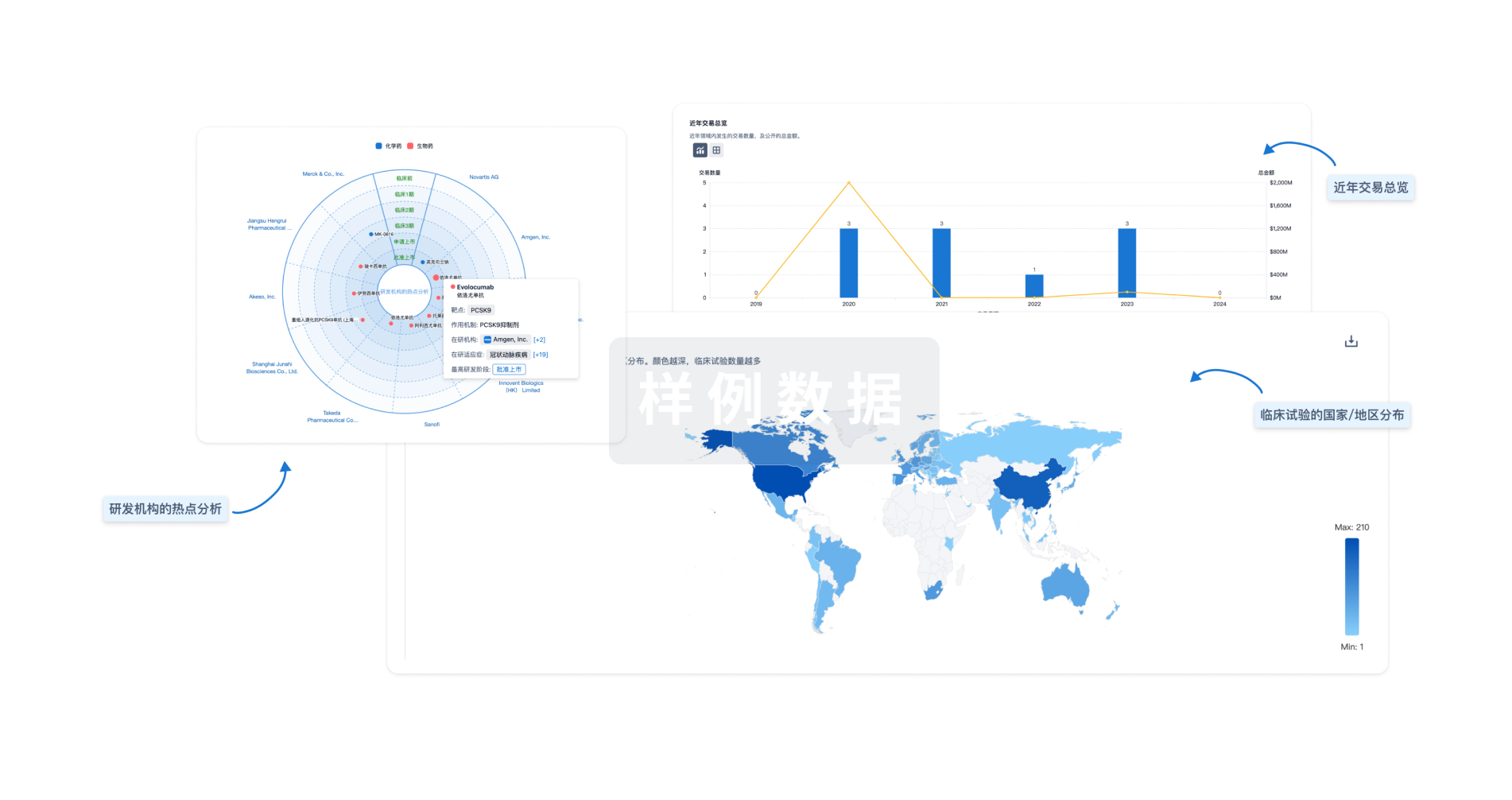预约演示
更新于:2025-05-07
WNT2
更新于:2025-05-07
基本信息
别名 Int-1-like protein 1、Int-1-related protein、INT1L1 + [4] |
简介 Ligand for members of the frizzled family of seven transmembrane receptors. Functions in the canonical Wnt signaling pathway that results in activation of transcription factors of the TCF/LEF family (PubMed:20018874). Functions as a upstream regulator of FGF10 expression. Plays an important role in embryonic lung development. May contribute to embryonic brain development by regulating the proliferation of dopaminergic precursors and neurons (By similarity). |
关联
100 项与 WNT2 相关的临床结果
登录后查看更多信息
100 项与 WNT2 相关的转化医学
登录后查看更多信息
0 项与 WNT2 相关的专利(医药)
登录后查看更多信息
1,034
项与 WNT2 相关的文献(医药)2025-05-01·International Journal of Biological Macromolecules
Structural characterization and hypoglycemic activity of a polysaccharide from Imperatae Rhizoma
Article
作者: Mi, Shengcheng ; Tian, Yaoyao ; Yan, Wu ; Xiong, Xianghong ; Mu, Liqiang ; Lu, Qi ; Wei, Lingge
2025-05-01·Neurogastroenterology & Motility
High‐Resolution Manometry With Solid Provocative Test in Patients With Mid‐Thoracic and Epiphrenic Esophageal Diverticula
Article
作者: Branche, Julien ; Melchior, Chloé ; Hambli, Sofia ; Wuestenberghs, Fabien ; Baravian, Loris ; Gérard, Romain ; Gourcerol, Guillaume ; Piessen, Guillaume ; Wils, Pauline
2025-04-24·Combinatorial Chemistry & High Throughput Screening
MiR-26a-5p/EZH2 Mediates Wnt2 Promoter Methylation to Regulate Trophoblast Dysfunction
Article
作者: Yu, Ning ; Liu, Yufang ; Wei, Shiqi ; Zhou, Xiaoyu
10
项与 WNT2 相关的新闻(医药)2025-03-22
·生物世界
撰文丨王聪
编辑丨王多鱼
排版丨水成文
药物性肝损伤(Drug-induced liver injury,DILI)涉及多方面的发病机制,需要有效的治疗策略。肝窦内皮细胞(LSEC)分泌的 Wnt2 可激活 Wnt/β-catenin 信号通路,从而促进肝细胞损伤后的增殖。
2025 年 3 月 21 日,空军军医大学附属西京医院王琳教授、何飞助理研究员、段娟丽副研究员等在 Cell 子刊 Cell Reports Medicine 上发表了题为:A combined “eat me/don’t eat me” strategy based on exosome for acute liver injury treatment 的研究论文。
该研究开发了一种基于外泌体的“吃我/别吃我”联合策略,通过多肽修饰让外泌体特异性靶向肝窦内皮细胞(吃我),通过工程化表达 CD47 蛋白让外泌体避免被单核吞噬细胞系统(MPS)清除(别吃我),并通过外泌体递送 Wnt2 mRNA,促进肝损伤后的肝脏再生,从而发挥急性肝损伤后的保护和治疗。
为应对靶向递送和逃避免噬的双重挑战,研究团队开发了一种基于外泌体的“吃我/别吃我”(eat me/don’t eat me)联合策略。该策略结合了双重靶向效应,以最大程度减少外泌体被巨噬细胞捕获和清除,并增强对肝窦内皮细胞(LSEC)的靶向递送。
具体来说,研究团队用 DMPE-PEG2000-CRLTRKRGLK 对 bEnd.3 细胞来源的外泌体进行功能化处理,以增强其对肝窦内皮细胞(LSEC)的靶向能力;由此产生的 RLTR 修饰外泌体(命名为 RLTR-Exo)负责“吃我”策略。
相反,“别吃我”信号是通过使用源自 CD47OE-bEnd.3 的 CD47 工程化外泌体实现的,这进一步减少了外泌体被单核吞噬细胞系统(MPS)清除。此外,通过慢性毒转染将治疗性核酸药物(Wnt2 mRNA)加载稳定封装到外泌体中,从而构建了 RLTR-Wnt2@ExoCD47。
实验结果显示,在对乙酰氨基酚(APAP)和二甲基亚硝胺(DMN)诱导的小鼠肝损伤模型中,RLTR-Wnt2@ExoCD47 有效地减少了外泌体被 MPS 捕获和降解,增强了其在 LSEC 的靶向和积累,并改善了小鼠肝损伤的治疗效果,且无不良反应。
该研究的亮点:
RLTRKRGLK 多肽的表面修饰,使 LSEC 靶向的外泌体递送成为可能;
表面工程化表达 CD47 蛋白通过“别吃我”信号降低巨噬细胞的清除;
RLTR-Wnt2@ExoCD47 可减轻肝脏坏死,促进肝脏再生。
总的来说,该研究开发的工程化外泌体平台,为药物性肝损伤提供了一种治疗新策略。
论文链接:
https://www.cell.com/cell-reports-medicine/fulltext/S2666-3791(25)00106-5
设置星标,不错过精彩推文
开放转载
欢迎转发到朋友圈和微信群
微信加群
为促进前沿研究的传播和交流,我们组建了多个专业交流群,长按下方二维码,即可添加小编微信进群,由于申请人数较多,添加微信时请备注:学校/专业/姓名,如果是PI/教授,还请注明。
点在看,传递你的品味
信使RNA寡核苷酸
2025-03-04
2025年2月28日,华中农业大学/华中科技大学的研究团队在期刊《Cell Reports》上合作发表了题为“Intestinal microbiota affects the progression of colorectal cancer by participating in the host intestinal arginine catabolism”的研究论文。
2025年2月28日,华中农业大学/华中科技大学的研究团队在期刊《Cell Reports》上合作发表了题为“Intestinal microbiota affects the progression of colorectal cancer by participating in the host intestinal arginine catabolism”的研究论文。
https://www.cell.com/cell-reports/fulltext/S2211-1247(25)00141-X
https://www.cell.com/cell-reports/fulltext/S2211-1247(25)00141-X
研究结果表明,肠道菌群通过多种机制(多胺合成、NOS2/NO合成、肿瘤微环境改变)影响CRC进展。精氨酸治疗CRC的关键在于精准调控精氨酸的代谢方向,即剥夺CRC细胞摄取精氨酸,同时增加免疫细胞对精氨酸的利用。人工改变肠道微生物群以减少CRC细胞获取精氨酸,是潜在有效的治疗策略。
研究结果表明,肠道菌群通过多种机制(多胺合成、NOS2/NO合成、肿瘤微环境改变)影响CRC进展。精氨酸治疗CRC的关键在于精准调控精氨酸的代谢方向,即剥夺CRC细胞摄取精氨酸,同时增加免疫细胞对精氨酸的利用。
人工改变肠道微生物群以减少CRC细胞获取精氨酸,是潜在有效的治疗策略。
01
01
研究背景
研究背景
CRC肿瘤附近的肠道微生物群会与癌细胞竞争精氨酸的利用,从而限制癌细胞对精氨酸的利用,抑制CRC的恶化。细菌中以精氨酸为底物的酶包括精氨酸脱羧酶(ARG)、精氨酸脱氨酶和精氨酸琥珀酰转移酶(AST)。其中,AST是AST途径中的第一个酶,它将精氨酸转化为谷氨酸,从而消耗精氨酸。精氨酸脱羧酶和精氨酸脱氨酶可进一步合成多胺,从而影响CRC的进展。
CRC肿瘤附近的肠道微生物群会与癌细胞竞争精氨酸的利用,从而限制癌细胞对精氨酸的利用,抑制CRC的恶化。细菌中以精氨酸为底物的酶包括精氨酸脱羧酶(ARG)、精氨酸脱氨酶和精氨酸琥珀酰转移酶(AST)。其中,AST是AST途径中的第一个酶,它将精氨酸转化为谷氨酸,从而消耗精氨酸。精氨酸脱羧酶和精氨酸脱氨酶可进一步合成多胺,从而影响CRC的进展。
以往的研究表明,在CRC的起始阶段,补充精氨酸可抑制肿瘤发生和隐窝细胞的过度增殖;但在CRC的进展阶段,精氨酸也被发现可刺激肿瘤增殖。造成这种混乱的主要原因是,目前的研究尚未认识到肠道微生物群对肿瘤组织中精氨酸分解代谢的重要影响。
以往的研究表明,在CRC的起始阶段,补充精氨酸可抑制肿瘤发生和隐窝细胞的过度增殖;但在CRC的进展阶段,精氨酸也被发现可刺激肿瘤增殖。造成这种混乱的主要原因是,目前的研究尚未认识到肠道微生物群对肿瘤组织中精氨酸分解代谢的重要影响。
图形摘要
图形摘要
02
02
肠道微生物群AST通路通过Wnt信号通路加速CRC进展
肠道微生物群AST通路通过Wnt信号通路加速CRC进展
与Arg组或对照组相比,ArgΔacE组在Wnt信号通路中有大量DEGs。因此,肠道微生物群中精氨酸代谢缺陷可能通过Wnt信号通路影响CRC的进展。
与Arg组或对照组相比,ArgΔacE组在Wnt信号通路中有大量DEGs。因此,肠道微生物群中精氨酸代谢缺陷可能通过Wnt信号通路影响CRC的进展。
与对照组和Arg组相比,ArgΔacE组结肠组织中Wnt信号通路成分wnt2、wnt3、wnt5、wnt6、wnt10a和wnt16的表达水平显著上调。此外,与对照组相比,Arg组和ArgΔacE组的Wnt10a蛋白表达水平明显升高,而ArgΔacE组的β-catenin表达水平也明显升高。这些结果表明,单独补充精氨酸不能激活Wnt/β-catenin通路,但精氨酸补充和ΔacEcN联合使用可显著激活Wnt/β-catenin通路并加速CRC的进展。
与对照组和Arg组相比,ArgΔacE组结肠组织中Wnt信号通路成分wnt2、wnt3、wnt5、wnt6、wnt10a和wnt16的表达水平显著上调。此外,与对照组相比,Arg组和ArgΔacE组的Wnt10a蛋白表达水平明显升高,而ArgΔacE组的β-catenin表达水平也明显升高。这些结果表明,
单独补充精氨酸不能激活Wnt/β-catenin通路,但精氨酸补充和ΔacEcN联合使用可显著激活Wnt/β-catenin通路并加速CRC的进展。
肠道微生物群AST通路通过Wnt信号通路加速癌症进展
肠道微生物群AST通路通过Wnt信号通路加速癌症进展
03
03
总结
总结
1. 精氨酸在结直肠癌(CRC)进展中的双重作用
1. 精氨酸在结直肠癌(CRC)进展中的双重作用
精氨酸通过多胺合成途径(如转化为腐胺)加速CRC进展;
精氨酸通过多胺合成途径(如转化为腐胺)加速CRC进展;
精氨酸通过NOS2产生NO,改善免疫反应,从而缓解CRC进展;
精氨酸通过NOS2产生NO,改善免疫反应,从而缓解CRC进展;
CRC细胞因精氨琥珀酸合成酶和鸟氨酸转氨甲酰酶活性降低,无法合成精氨酸,表现出精氨酸营养不良。
CRC细胞因精氨琥珀酸合成酶和鸟氨酸转氨甲酰酶活性降低,无法合成精氨酸,表现出精氨酸营养不良。
2. 精氨酸相关治疗策略
2. 精氨酸相关治疗策略
精氨酸剥夺疗法:通过精氨酸脱羧酶、精氨酸脱亚胺酶等分解精氨酸,从肿瘤微环境中去除精氨酸;
精氨酸剥夺疗法:通过精氨酸脱羧酶、精氨酸脱亚胺酶等分解精氨酸,从肿瘤微环境中去除精氨酸;
精氨酸补充疗法:通过增加肿瘤浸润免疫细胞对精氨酸的利用,增强肿瘤免疫力,延缓CRC进展;
精氨酸补充疗法:通过增加肿瘤浸润免疫细胞对精氨酸的利用,增强肿瘤免疫力,延缓CRC进展;
关键问题:如何准确剥夺CRC细胞对精氨酸的摄取,同时增加肿瘤浸润免疫细胞对精氨酸的摄取。
关键问题:如何准确剥夺CRC细胞对精氨酸的摄取,同时增加肿瘤浸润免疫细胞对精氨酸的摄取。
3. 肠道菌群对CRC进展的影响机制
3. 肠道菌群对CRC进展的影响机制
多胺合成途径:某些细菌(如大肠杆菌、粪肠球菌)增加结肠内容物中腐胺浓度,高浓度腐胺对CRC患者有害,可作为CRC标志物;
多胺合成途径:某些细菌(如大肠杆菌、粪肠球菌)增加结肠内容物中腐胺浓度,高浓度腐胺对CRC患者有害,可作为CRC标志物;
NOS2和NO合成途径:肠道菌群通过LPS激活NOS2表达,影响精氨酸的可用性,进而影响NO合成,NO在CRC进展中具有双重作用;
NOS2和NO合成途径:肠道菌群通过LPS激活NOS2表达,影响精氨酸的可用性,进而影响NO合成,NO在CRC进展中具有双重作用;
肿瘤微环境改变:肠道菌群通过精氨酸分解代谢影响肿瘤微环境,包括细胞因子表达(如CCL2)和巨噬细胞极化(M1和M2巨噬细胞);
肿瘤微环境改变:肠道菌群通过精氨酸分解代谢影响肿瘤微环境,包括细胞因子表达(如CCL2)和巨噬细胞极化(M1和M2巨噬细胞);
Wnt信号通路:精氨酸补充联合AST通路阻断菌株可显著上调Wnt信号通路,加速CRC进展。
Wnt信号通路:精氨酸补充联合AST通路阻断菌株可显著上调Wnt信号通路,加速CRC进展。
参考资料:
参考资料:
1.Bray, F. ∙ Laversanne, M. ∙ Sung, H. ...
1.Bray, F. ∙ Laversanne, M. ∙ Sung, H. ...
Global cancer statistics 2022: GLOBOCAN estimates of incidence and mortality worldwide for 36 cancers in 185 countries
Global cancer statistics 2022: GLOBOCAN estimates of incidence and mortality worldwide for 36 cancers in 185 countries
CA Cancer J. Clin. 2024; 74:229-263
CA Cancer J. Clin. 2024; 74:229-263
2.Kastrinos, F. ∙ Samadder, N.J. ∙ Burt, R.W.
2.Kastrinos, F. ∙ Samadder, N.J. ∙ Burt, R.W.
Use of family history and genetic testing to determine risk of colorectal cancer
Use of family history and genetic testing to determine risk of colorectal cancer
Gastroenterology. 2020; 158:389-403
Gastroenterology. 2020; 158:389-403
微生物疗法临床研究
2024-11-19
·奇点网
*仅供医学专业人士阅读参考“再一再二,没有再三再四”,奇点糕从小就听着这句话长大,所以才特别痛恨那种屡教不改、一直作恶的家伙。而就在短短半年里,乳酸促癌竟然在奇点糕这儿露脸了三回,比如上次复旦团队发现的组蛋白乳酸化修饰促肝癌,是不是够让人咬牙切齿、除之而后快的?而要想斩断乳酸促癌的黑手,当务之急肯定是阐明相关调控机制、寻找潜在治疗靶点了。今天,浙江大学医学院吕志民团队与美国莱斯大学陶一之团队合作,在Cell Metabolism期刊发表的最新研究成果[1],即首次揭示了调控乳酰辅酶A(Lactyl-CoA)依赖性组蛋白乳酸化修饰的重要靶点——乳酰辅酶A合成酶ACSS2,它与乳酰转移酶KAT2A的结合和相互作用,能够促进组蛋白乳酸化、肿瘤生长和免疫逃逸。该研究显示,ACSS2能够将乳酸脱氢酶A(LDHA)产生的乳酸直接转化为乳酰辅酶A,随后由EGFR通路激活诱导的ERK磷酸化,会介导ACSS2蛋白S267位点磷酸化,使其发生核转位并与KAT2A共同组成复合物,随后调控组蛋白H3乳酸化修饰,进而上调Wnt/β-catenin、NF-κB和PD-L1等关键信号通路/分子的表达水平,起到促癌效应。一图总结论文核心内容有组蛋白乳酸化修饰,就肯定会先有肿瘤微环境里乳酸的增多,而经典的EGFR通路激活,就已经被证实可通过促进Warburg效应增加乳酸产生,研究者们本次探索也由此入手,证实EGFR通路激活确实会使胶质母细胞瘤(GBM)细胞整体的蛋白质乳酸化修饰水平上升,但组蛋白H3的乳酸化(主要发生在K14和K18位点)却不能单纯靠激活EGFR通路实现。通过逐个敲除介导组蛋白酰基化修饰(histone acylations)的调控酶,研究者们证实EGFR通路激活诱导的组蛋白H3乳酸化,必须要由KAT2A作为乳酰转移酶进行直接调控,且KAT2A上存在高度选择性结合乳酰辅酶A的R533位点。但另外一个问题又浮现了:KAT2A能参与不止一种组蛋白酰基化修饰,比如更有名的乙酰化修饰,而人体内的乳酰辅酶A水平其实明显低于乙酰化修饰要用到的乙酰辅酶A(acetyl-CoA),那KAT2A要怎么找到乳酰辅酶A来结合呢?研究者们推测,KAT2A或许能与某种乳酰辅酶A合成酶联手,“在本地生产”乳酰辅酶A用于组蛋白乳酸化修饰,于是借助质谱分析和免疫共沉淀分析,筛选了GBM细胞内能与KAT2A发生相互作用的蛋白质,这才让ACSS2浮出水面。而EGFR通路激活也确实会上调ACSS2表达水平,这就和前面串起来了,且EGFR通路激活还会使ACSS2的S267位点被ERK磷酸化,以及PIN1酶依赖性的顺反异构化(cis-trans isomerization)。在这么多重调控的影响下,ACSS2就会发生核转位(由输入蛋白α5调控),正式去与KAT2A搭伙,研究者们还专门证实,包含ACSS2和KAT2A的复合物其实还有第三个成员LDHA,而ACSS2能立刻将LDHA在细胞核内产生的乳酸转化为乳酰辅酶A,所以才叫“本地生产”。到这里,EGFR通路激活诱导ACSS2-KAT2A依赖性组蛋白H3乳酸化的过程就完整了。EGFR通路激活诱导ACSS2-KAT2A依赖性组蛋白H3乳酸化而正如奇点糕一开始提到的,由ACSS2和KAT2A“主持”的组蛋白H3乳酸化修饰,对GBM等肿瘤生长和免疫逃逸有重要作用,都不用多看别的,看到被组蛋白H3乳酸化修饰的基因里有WNT2/WNT5A、CTNNB1(编码β-catenin)、CD274(编码PD-L1)、NFKB2这些名字,奇点糕就已经感觉头皮发麻了,里面哪有善茬啊?最后一部分实验结果也不出所料,阻断ACSS2和KAT2A的功能(使关键位点失活,如KAT2A R533A突变型蛋白)或抑制二者的相互作用,可在小鼠实验中有效抑制GBM肿瘤生长、延长小鼠存活时间,并与PD-1抑制剂治疗协同增效,如果这一招未来能成功向临床转化,对GBM等缺乏有效治疗手段的难治性实体瘤来说可就是“及时雨”啦。参考文献:[1]Zhu R, Ye X, Lu X, et al. ACSS2 acts as a lactyl-CoA synthetase and couples KAT2A to function as a lactyltransferase for histone lactylation and tumor immune evasion[J]. Cell Metabolism, 2024. [2]Makinoshima H, Takita M, Matsumoto S, et al. Epidermal growth factor receptor (EGFR) signaling regulates global metabolic pathways in EGFR-mutated lung adenocarcinoma[J]. Journal of Biological Chemistry, 2014, 289(30): 20813-20823.本文作者丨谭硕
临床结果
分析
对领域进行一次全面的分析。
登录
或

生物医药百科问答
全新生物医药AI Agent 覆盖科研全链路,让突破性发现快人一步
立即开始免费试用!
智慧芽新药情报库是智慧芽专为生命科学人士构建的基于AI的创新药情报平台,助您全方位提升您的研发与决策效率。
立即开始数据试用!
智慧芽新药库数据也通过智慧芽数据服务平台,以API或者数据包形式对外开放,助您更加充分利用智慧芽新药情报信息。
生物序列数据库
生物药研发创新
免费使用
化学结构数据库
小分子化药研发创新
免费使用